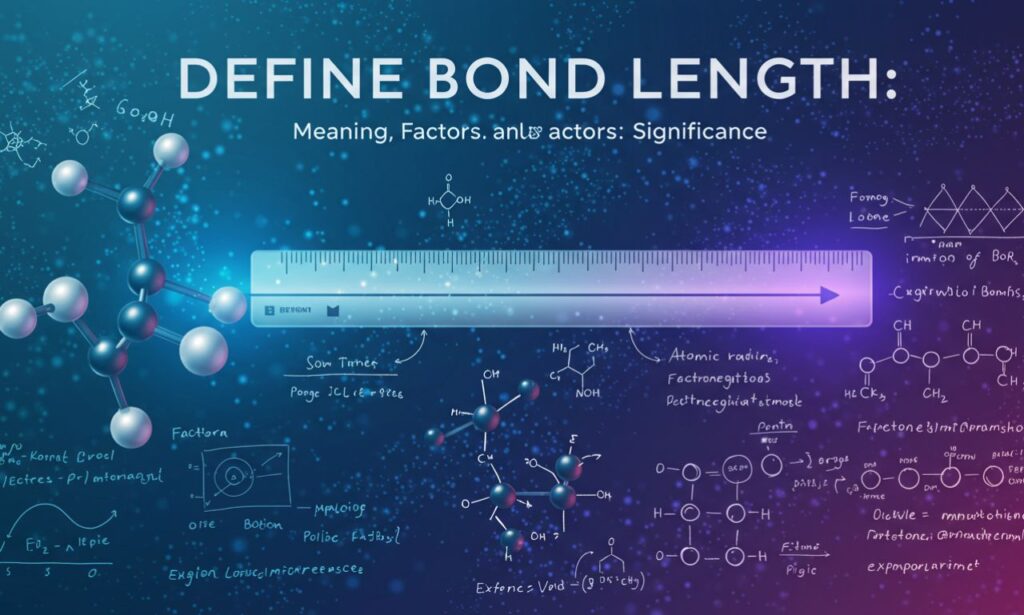To understand molecular structures, it is essential to define bond length—a fundamental concept in chemical bonding and molecular geometry. Bond length is the average distance between the nuclei of two bonded atoms in a molecule. It plays a key role in determining the shape, reactivity, and properties of chemical compounds.
When we define bond length, we also begin to grasp why certain molecules behave differently based on atomic size, bonding strength, and electron interactions. This article explains the concept, factors affecting it, its measurement, and real-world applications.
Define Bond Length: Basic Concept and Units
To clearly define bond length, it refers to the equilibrium distance between the nuclei of two atoms that are chemically bonded. It is typically measured in picometers (pm) or angstroms (Å), where:
-
1 Å = 10⁻¹⁰ meters
-
1 pm = 10⁻¹² meters
For example, the bond length of a hydrogen molecule (H₂) is about 74 pm. This distance is a balance between the attractive and repulsive forces between atoms. If atoms get too close, repulsion increases; too far, and the bond weakens.
Why Chemists Define Bond Length
To define bond length is to understand how atoms connect in stable arrangements. Chemists use this knowledge to:
-
Predict molecular structure
-
Understand physical properties
-
Determine polarity and reactivity
-
Evaluate bond strength
-
Analyze spectroscopic data
A shorter bond length often indicates a stronger bond, while longer bond lengths usually suggest weaker interactions.
Factors That Affect Bond Length
Several variables influence how we define bond length in practice. These include:
1. Bond Order
Bond order refers to the number of chemical bonds between a pair of atoms:
-
Single bond > longer
-
Double bond > shorter
-
Triple bond > shortest
For example:
-
C–C single bond: ~154 pm
-
C=C double bond: ~134 pm
-
C≡C triple bond: ~120 pm
2. Atomic Size
Larger atoms have longer bond lengths. For example:
-
H–F bond: ~92 pm
-
H–Cl bond: ~127 pm
-
H–Br bond: ~141 pm
3. Electronegativity
Differences in electronegativity affect the electron cloud distribution, slightly altering the bond length.
4. Resonance
In structures with resonance, bond lengths become equalized between single and double bond lengths, as in benzene.
5. Hybridization
Bond length changes with the type of hybrid orbital:
-
sp (50% s character): shortest
-
sp² (33% s character)
-
sp³ (25% s character): longest
How Scientists Define Bond Length Experimentally
To define bond length accurately, chemists use several techniques:
1. X-ray Crystallography
A powerful method where X-rays are diffracted through a crystal lattice to determine atomic positions.
2. Electron Diffraction
Used for gas-phase molecules. Electrons scatter off nuclei, and bond lengths are inferred from the diffraction pattern.
3. Spectroscopy
Infrared and microwave spectroscopy provide bond lengths by analyzing vibrational and rotational spectra.
Bond Length vs Bond Energy
When you define bond length, it’s important to consider its relationship with bond energy—the energy required to break a bond. In general:
-
Shorter bond length = Higher bond energy
-
Longer bond length = Lower bond energy
For example:
-
H–H bond (74 pm): ~436 kJ/mol
-
H–I bond (161 pm): ~297 kJ/mol
The inverse relationship is critical in understanding chemical stability and reaction mechanisms.
Define Bond Length in Covalent and Ionic Bonds
Covalent Bonds
In covalent bonds, bond length is based on shared electron pairs. It depends heavily on bond order and hybridization.
Ionic Bonds
Although ionic compounds don’t have “true” bond lengths due to electrostatic interactions, the internuclear distances are still considered effective bond lengths.
In NaCl:
-
Na⁺ and Cl⁻ are separated by ~282 pm, considered the “bond length” in the lattice structure.
Define Bond Length in Molecular Geometry
When predicting molecular shapes using VSEPR theory or computational chemistry, it’s crucial to define bond length because it helps determine:
-
Bond angles
-
Molecular polarity
-
Electron cloud distribution
Molecules like water (H₂O) or carbon dioxide (CO₂) are modeled based on their bond lengths and angles to better predict chemical behavior.
Real-World Applications of Bond Length
Chemists, physicists, and engineers often define bond length to apply this knowledge in fields like:
1. Drug Design
Understanding molecular dimensions helps pharmaceutical companies design better drug-receptor interactions.
2. Nanotechnology
At nanoscale, bond lengths affect how materials behave under stress, temperature, and electromagnetic fields.
3. Material Science
Strong and stable materials are often the result of short, high-energy bonds between atoms.
4. Environmental Chemistry
Understanding bond lengths of greenhouse gases like CO₂ and CH₄ helps scientists model atmospheric behavior and global warming potential.
How Bond Length Influences Chemical Reactions
When two molecules react, the bonds must break and form anew. Thus, to predict whether a reaction is favorable, chemists define bond length and calculate:
-
Activation energy
-
Transition state geometry
-
Thermodynamic feasibility
Shorter bonds may resist breakage but release more energy when formed.
Define Bond Length in Organic Chemistry
In organic molecules, carbon-based chains and rings exhibit various bond lengths. For example:
-
C–C single bond in alkanes: ~154 pm
-
C=C double bond in alkenes: ~134 pm
-
Aromatic bonds in benzene: ~139 pm (resonance-stabilized)
The ability to define bondlength allows chemists to identify aromatic systems, understand stability, and predict reactivity.
Bond Length in Modern Computational Chemistry
With the advancement of software like Gaussian and ORCA, chemists can now define bond length through computational models. These tools help in:
-
Visualizing molecular structures
-
Predicting bond lengths and energies
-
Simulating reactions before performing them in the lab
Such modeling saves time, money, and hazardous experimentation.
Summary: Why It Matters to Define Bond Length
To define bondlength is to unlock the basics of molecular structure, stability, and chemical behavior. Whether in academic research, pharmaceutical innovation, or environmental modeling, understanding bond lengths empowers scientists to predict, manipulate, and optimize molecular systems.
From predicting a compound’s reactivity to designing new materials and drugs, bondlength plays a foundational role in modern science.
Conclusion
When we define bondlength, we go beyond just measuring the distance between atoms—we explore how atoms interact, how molecules behave, and how materials form. This fundamental concept serves as a cornerstone for understanding chemical bonding, molecular geometry, and material properties. As science progresses, our ability to define, measure, and apply bond lengths will only grow in precision and impact.







